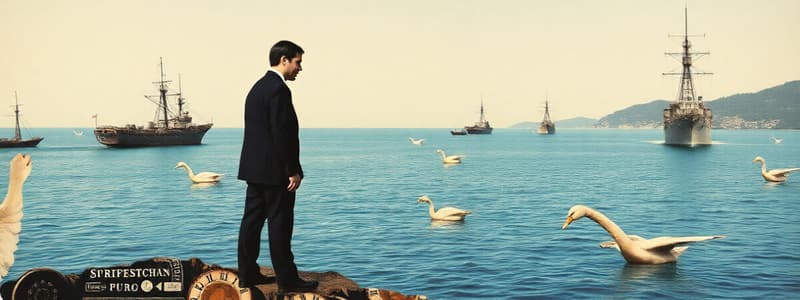Podcast
Questions and Answers
Foreign policy is outward-looking and seeks to promote the national ______.
Foreign policy is outward-looking and seeks to promote the national ______.
interest
The South China Sea is referred to as 'the second ______ Gulf' due to its significant energy reserves.
The South China Sea is referred to as 'the second ______ Gulf' due to its significant energy reserves.
Persian
The South China Sea is a major route for global commercial ______ and naval operations.
The South China Sea is a major route for global commercial ______ and naval operations.
shipping
In 2013, the U.S. flew B-52 bombers through ______ airspace after China’s claim.
In 2013, the U.S. flew B-52 bombers through ______ airspace after China’s claim.
The U.S. rejects China’s sovereignty claim over most of the South China Sea ______.
The U.S. rejects China’s sovereignty claim over most of the South China Sea ______.
Commodore Matthew Perry opened Japan to trade after two centuries of ______.
Commodore Matthew Perry opened Japan to trade after two centuries of ______.
The international court rejected China’s territorial ______ in 2016.
The international court rejected China’s territorial ______ in 2016.
The Spratly and Paracel Islands are major ______ in the South China Sea dispute.
The Spratly and Paracel Islands are major ______ in the South China Sea dispute.
On May 8, 2019, the U.S. announces a new round of ______.
On May 8, 2019, the U.S. announces a new round of ______.
Iran plans to increase ______ enrichment, violating the 2015 agreement.
Iran plans to increase ______ enrichment, violating the 2015 agreement.
The U.S. and Saudi Arabia blame ______ for the attack on a Saudi oil pipeline.
The U.S. and Saudi Arabia blame ______ for the attack on a Saudi oil pipeline.
On June 20, 2019, Iran shoots down a U.S. ______ surveillance drone.
On June 20, 2019, Iran shoots down a U.S. ______ surveillance drone.
Trump cancels a military strike due to concerns about civilian ______.
Trump cancels a military strike due to concerns about civilian ______.
The U.S. conducts a cyberattack against the Iranian database used to target ______ in the Persian Gulf.
The U.S. conducts a cyberattack against the Iranian database used to target ______ in the Persian Gulf.
Iran begins exceeding uranium enrichment ______.
Iran begins exceeding uranium enrichment ______.
The UK seizes an Iranian tanker headed to ______, violating EU sanctions.
The UK seizes an Iranian tanker headed to ______, violating EU sanctions.
Growing concerns about a backlash against globalization have led to ______ and nationalism.
Growing concerns about a backlash against globalization have led to ______ and nationalism.
The debate over American hegemony includes whether the U.S. acts as an empire or a ______.
The debate over American hegemony includes whether the U.S. acts as an empire or a ______.
Challenges to U.S. dominance include the rise of ______ and Russia.
Challenges to U.S. dominance include the rise of ______ and Russia.
The discrepancy in global opinion often centers around U.S. foreign policy and considerations of other countries' ______.
The discrepancy in global opinion often centers around U.S. foreign policy and considerations of other countries' ______.
International crises are characterized by high surprise, high threat, and short ______ times.
International crises are characterized by high surprise, high threat, and short ______ times.
The June 2019 U.S.-Iran conflict aimed for U.S. ______ and possibly regime change.
The June 2019 U.S.-Iran conflict aimed for U.S. ______ and possibly regime change.
In retaliation, Iran designated the U.S. Central Command as a ______ group.
In retaliation, Iran designated the U.S. Central Command as a ______ group.
The first round of economic sanctions against Iran was initiated on ______ 7, 2018.
The first round of economic sanctions against Iran was initiated on ______ 7, 2018.
The U.S. has ______ intervened in the political affairs of states outside the Western Hemisphere.
The U.S. has ______ intervened in the political affairs of states outside the Western Hemisphere.
Isolationism allowed Americans to focus on ______ and economic growth.
Isolationism allowed Americans to focus on ______ and economic growth.
During the 19th century, many Americans believed in 'manifest ______'.
During the 19th century, many Americans believed in 'manifest ______'.
Promoting ______ became a rationalization for American interventionism in the 20th century.
Promoting ______ became a rationalization for American interventionism in the 20th century.
The phrase 'a friend today could become a ______ tomorrow' expresses a realist view in foreign policy.
The phrase 'a friend today could become a ______ tomorrow' expresses a realist view in foreign policy.
Throughout most of its history, the U.S. has embraced ______, acting independently in international affairs.
Throughout most of its history, the U.S. has embraced ______, acting independently in international affairs.
After the two world wars, the U.S. began to favour ______.
After the two world wars, the U.S. began to favour ______.
The debate of idealism vs. ______ in U.S. foreign policy revolves around visions versus reality.
The debate of idealism vs. ______ in U.S. foreign policy revolves around visions versus reality.
Structural Realism suggests that states respond to changes in the international distribution of ______.
Structural Realism suggests that states respond to changes in the international distribution of ______.
According to Neoclassical Realism, the responses of states to systemic trends are influenced by ______ factors.
According to Neoclassical Realism, the responses of states to systemic trends are influenced by ______ factors.
Constructivism examines how ______, interests, and ideas are socially constructed.
Constructivism examines how ______, interests, and ideas are socially constructed.
In Marxism, capitalism is viewed as a driving force behind imperialist ______.
In Marxism, capitalism is viewed as a driving force behind imperialist ______.
Feminism critiques the ______ nature of International Relations.
Feminism critiques the ______ nature of International Relations.
Liberalism emphasizes the importance of ______, international institutions, and the spread of democracy.
Liberalism emphasizes the importance of ______, international institutions, and the spread of democracy.
Marxism explains that people do not fight against the ruling class due to being fed a false ______ vision.
Marxism explains that people do not fight against the ruling class due to being fed a false ______ vision.
In Liberalism, multiple domestic ______ influence foreign policy.
In Liberalism, multiple domestic ______ influence foreign policy.
Flashcards are hidden until you start studying
Study Notes
Foreign Policy Overview
- Foreign policy aims to promote a nation's interests beyond its borders.
- It involves anticipating threats and recognizing opportunities abroad.
- Examples include the U.S. response to China's actions in the South China Sea.
The South China Sea
- Covers 648,000 square nautical miles.
- Surrounding countries include China, Vietnam, the Philippines, Brunei, Malaysia, and Taiwan.
- Disputed landforms include over 400 to 600 rocks, reefs, atolls, and islands.
- Major groups include the Spratly and Paracel Islands.
U.S. Stance
- No official position on territorial claims, but rejects China's sovereignty claims over most of the region.
- Tensions escalated with China due to conflicting territorial claims.
Key Strategic Factors
- Critical Passageway: Major route for global commercial shipping and naval operations, six times the oil flow compared to the Suez Canal.
- Potential Natural Resources: Significant energy reserves.
- Strategic Importance to China: Comparable to the Caribbean's importance to the U.S., integral to China's foreign policy and defense strategies.
U.S.-China Tensions
- 2013: U.S. flew B-52 bombers after China's claim.
- 2014: China placed an oil rig in disputed waters, increasing tension.
- 2015-2016: China built artificial islands for military purposes.
- 2016: International Court of Justice rejected China's claims.
- 2018: U.S.-China military encounters, including a near collision.
Historical Context: The First Asian Pivot
- Commodore Matthew Perry (1853) opened Japan to trade.
- Treaty of Kanagawa (1854) established U.S. coaling stations.
- Later treaties expanded U.S. influence.
- Growing concerns about a backlash against globalization, leading to populism and nationalism.
American Hegemony
- Debate exists on whether the U.S. functions as an empire or a global government.
- Challenges include the rise of China and Russia.
Global Opinion on U.S. Foreign Policy
- Disparity between American views on considering other countries' interests and global perceptions.
- Varied perceptions of global threats, including climate change, cyberattacks, and U.S. power.
U.S. Foreign Policy and Global Trends (2035)
- National Intelligence Council predicts increased global disorder and competition.
- Growing complexity of international issues, requiring cooperation.
- Fragmentation of global citizenry complicates democratic governance and policy-making.
International Crises
- High surprise, threat, and short response times.
- Characterized by action-reaction cycles leading to escalation and potential loss of control.
- Example: June 2019 U.S.-Iran conflict.
Chronology of Events (US-Iran Conflict)
- May 8, 2018: U.S. withdraws from the Iran nuclear agreement.
- May 21, 2018: Pompeo presents demands for Iran to meet.
- Aug. 7, 2018: U.S. initiates sanctions against Iran.
- Nov. 5, 2018: Second round of sanctions announced.
- Apr. 8, 2019: U.S. designates the IRGC as a terrorist group.
- May 5, 2019: U.S. deploys military assets to the Middle East.
- May 8, 2019: New sanctions announced, Iran plans uranium enrichment.
- May 12, 2019: Ships sabotaged, Iran denies involvement.
- May 14, 2019: Saudi oil pipeline attacked, U.S. blames Iran.
- May 19, 2019: Rocket near U.S. embassy in Baghdad.
- May 24, 2019: U.S. deploys more troops to the Middle East.
- June 13, 2019: Two tankers attacked, video shows Iranian boats.
- June 17, 2019: Iran announces it will breach uranium enrichment limits.
- June 20, 2019: Iran shoots down a U.S. drone.
U.S. Decision-Making on Military Action
- Initial response considered military action after the drone incident but hesitates due to potential casualties.
- Trump initially supports military action but cancels it due to concerns about civilian casualties.
Aftermath and Action-Reaction Cycle
- U.S. conducts a secret cyberstrike against Iranian databases.
- UK seizes an Iranian tanker, violating EU sanctions. Iran retaliates by seizing a British tanker.
- Iran exceeds uranium enrichment limits, U.S. responds with sanctions.
- Houthi rebels attack Saudi oil facilities, escalating tensions.
US Foreign Policy Themes
- Isolationism: Avoiding entanglement in foreign affairs.
- Moralism: Viewing U.S. government and policy as superior, promoting liberty and justice abroad.
- Pragmatism: Acting in the best interest of the U.S.
- Unilateralism: Acting independently, without consulting other states.
Competing Themes
- Idealism vs. Realism: Should foreign policy be based on visions or deal with reality?
- Isolationism vs. Involvement: Should the U.S. intervene in international affairs?
- Unilateralism vs. Multilateralism: Should the U.S. act alone or with other nations?
Theories of International Relations
- Realism: Focuses on power and self-interest.
- Liberalism: Emphasizes cooperation, democracy, and institutions.
- Constructivism: Examines socially constructed ideas and identities.
- Marxism: Explores capitalism, economic exploitation, and imperialism.
- Feminism: Critiques the male-dominated nature of IR and highlights female perspectives.
Studying That Suits You
Use AI to generate personalized quizzes and flashcards to suit your learning preferences.


